Explore the latest insights from top science journals in the Muser Press daily roundup (July 15, 2025), featuring impactful research on climate change challenges.
In brief:
How the wind shapes the waves
An international research team led by the Helmholtz-Zentrum Hereon has, for the first time, succeeded in visualizing and quantifying the complex airflow dynamics directly above the ocean surface in high resolution. Using an innovative laser measurement system, previously unknown and highly complex mechanisms of energy exchange between wind and waves have been deciphered – a significant step forward for climate research, weather models, and ocean dynamics.
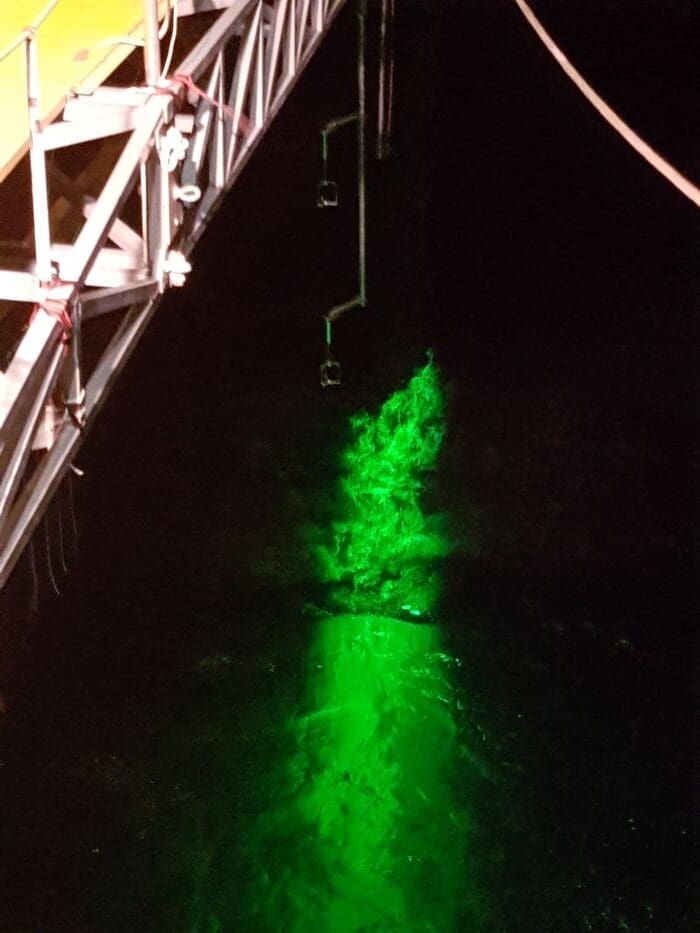
The research findings have been published in Nature Communications.
The international team, led by Dr. Marc Buckley from the Hereon Institute of Coastal Ocean Dynamics, has achieved a breakthrough in high-resolution imaging of the ocean surface. Using a specially developed laser measurement system aboard the research platform FLIP (Floating Instrument Platform) in the Pacific Ocean, they were able to capture high-resolution images of airflow just a few millimeters to one meter above the ocean surface. They identified two wind-wave coupling mechanisms that occur simultaneously but act differently.
Short waves, about one meter in length, move slower than the wind. This causes a separation of the airflow: the wave crest blocks the wind, creating a pressure difference that transfers energy to the wave. Long waves, on the other hand – up to 100 meters in length – move faster than the wind and generate different airflow patterns through their motion. These mechanisms operate simultaneously in different parts of the wave field – a crucial insight for advancing atmospheric and oceanic models.
Relevance for Weather, Climate, and Marine Biochemistry
The interactions between wind and waves are a central component of the Earth’s climate and weather systems. While it is largely accepted that these complex interactions control the exchange of energy, heat, and greenhouse gases between the atmosphere and the ocean – affecting sea state, weather, and currents, the mechanisms remain, until today, largely unknown. The research team plans to further develop the system to also capture movements below the water surface with greater precision.
“Until now, no one has measured the airflow this close to the ocean surface, let alone mapped the mechanisms of energy exchange at such a fine scale,” says lead author Buckley. “Our observations shed light on a physical frontier. This will enable us to advance the theoretical framework and develop more accurate descriptions of air-sea exchange processes, which have so far been only partially understood.”
The imagery is based on a laser that passes through both air and water: the green beam hits water droplets introduced into the air – similar to mist illuminated by sunlight. These droplets follow the motion of the airflow, scatter the laser light, and make even the smallest movements in the air visible.
At the same time, the laser penetrates the water surface. At the wind-driven surface, the light is refracted – revealing the structure of the water surface. This combination allows both the air and water sides to be visualized. The method is based on Particle Image Velocimetry (PIV), an established technique in fluid dynamics. PIV provides precise information about flow structure and wind speeds. This marks the first time the technique has been used over the open ocean.
Cutting-edge research for a changing world
Helmholtz-Zentrum Hereon`s scientific research aims at preserving a world worth living in. To this end, around 1000 employees generate knowledge and research new technologies for greater resilience and sustainability – for the benefit of the climate, the coast and people. The path from idea to innovation leads through a continuous interplay between experimental studies, modeling and AI to digital twins that map the diverse parameters of climate and coast or human biology in the computer.
This is an interdisciplinary approach that spans from the fundamental scientific understanding of complex systems to scenarios and practical applications. As an active member of national and international research networks and the Helmholtz Association, Hereon supports politics, business and society in shaping a sustainable future by transferring the expertise it has gained.
Journal Reference:
Buckley, M.P., Horstmann, J., Savelyev, I. et al., ‘Direct observations of airflow separation over ocean surface waves’, Nature Communications 16, 5526 (2025). DOI: 10.1038/s41467-025-61133-1
Article Source:
Press Release/Material by Helmholtz-Zentrum Hereon
Jaguar population increases after wildfire and drought, indicating area’s role as climate refuge
Following a large-scale wildfire, more jaguars migrated to a study site in the Brazilian wetlands that already had the largest population density of jaguars in the world, a new study found.
“Finding even more jaguars and other mammals in the study area following the 2020 wildfire and extreme drought suggests that it may serve as a climate refuge, buffering the effects of extreme climate events,” said Charlotte Eriksson, a post-doctoral scholar at Oregon State University.
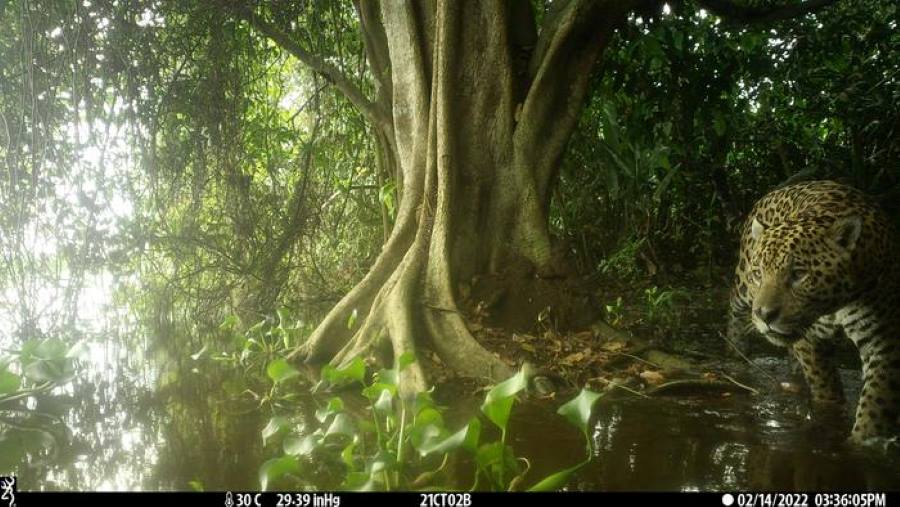
The 36,700-acre site is a seasonally flooded protected area in the northern portion of the Brazilian Pantanal, the largest freshwater wetland in the world.
Past research by Eriksson and others at Oregon State and in Brazil found the site is home to a population of jaguars that are unique because their diet primarily consists of aquatic organisms, instead of land-based animals, and because they are more socially tolerant and willing to share space with other jaguars.
For the new study, published in Global Change Biology, the researchers, who have studied the jaguars since 2014, used video of jaguars and other mammals they captured from field cameras they deployed before, during and after the wildfire. They also collected nearly 175 jaguar scats to analyze the jaguars’ diet.
The study site, much of which is federally protected, is five hours from the nearest town and can only be accessed by humans via boat. There are no roads, trails or settlements nearby. Researchers cover themselves from head to toe because of the abundance of biting insects.
Eriksson has been working on the project since 2017, first as a doctoral student in Oregon State Professor Taal Levi’s lab and now as a post-doctoral scholar. She visited the study site in 2018 and 2021.
Jaguars are the most frequently detected mammals detected by the cameras, which is highly unusual for a large, solitary carnivore, Eriksson said. She said that would be similar to most frequently seeing a cougar or mountain lion on cameras in North America, instead of for example deer.
She said that whenever she got off the boat, she would see jaguar tracks. In fact, one of her cameras recorded a jaguar just seven minutes after she set it up.
“I have never been to a place where the presence of a large carnivore is so obvious,” she said.
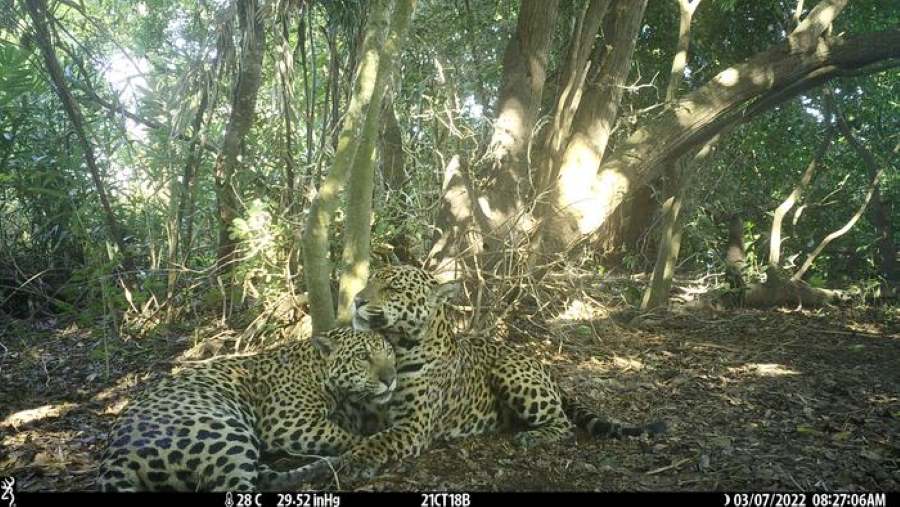
The 2020 wildfires, driven by extreme drought, extreme temperatures and human activities, burned more than 11 million acres, including half the study site, and caused an estimated loss of 17 million vertebrates.
In the just-published paper, the researchers set out to understand the short-term impacts of the fire and long-term effects of drought on the population of jaguars and other mammals and whether the changes were driven by fire, drought or both.
Findings included:
- Jaguar activity initially declined post-fire, indicating a short-term impact, but rebounded over time, with a significant increase in abundance and birth of cubs one year after the fire.
- Jaguars living in the area before the fire were sighted at similar rates before and after the fire, indicating that resident jaguars survived the fires and maintained their home ranges, while a large number of immigrant jaguars arrived from other areas, indicating the area served as a climate refuge.
- Richness and abundance of other mammal species increased across the study period, but was more strongly correlated with drought-induced changes than with fire-related impacts because the increase in species richness began in 2018 – before the fire. Researchers also didn’t find a significant difference in species richness between camera sites burned during the fire or not burned.
- Jaguars maintained their specialization on aquatic prey, particularly fish and caiman alligators, despite the increase in mammals, supporting the hypothesis that consumption of aquatic prey reduces predation pressure on land-based mammals.
The researchers caution against generalizing their findings to other areas because of the unique nature of this part of the Pantanal, including the fact that parts of it are protected, but they emphasize the importance of maintaining such refugia and implementing proactive fire management.
Journal Reference:
Eriksson, C. E., D. L. Z. Kantek, S. S. Miyazaki, et al., ‘Wildfire and Drought Alter the Ecology of Jaguars and Co-Occurring Mammals in the World’s Largest Wetland’, Global Change Biology 31, 7: e70344 (2025). DOI: 10.1111/gcb.70344
Article Source:
Press Release/Material by Oregon State University
Smarter tools for policymakers: Notre Dame researchers target urban carbon emissions, building by building
Carbon emissions continue to increase at record levels, fueling climate instability and worsening air quality conditions for billions in cities worldwide. Yet despite global commitments to carbon neutrality, urban policymakers still struggle to implement effective mitigation strategies at the city scale.
Now, researchers at Notre Dame’s School of Architecture, the College of Engineering and the Lucy Family Institute for Data & Society are working to reduce carbon emissions through advanced simulations and a novel artificial intelligence-driven tool, EcoSphere.
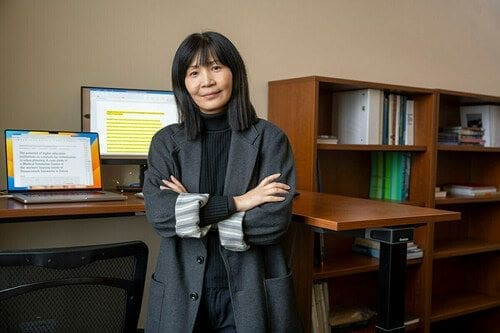
“Our goal is to develop tools that assess the carbon emission reduction and mitigation potentials of the built environment infrastructure – both through renovation and improved new construction. At the city scale, such a tool can offer data on building components and lifespans to support decision-making by policymakers and city planners,” said Ming Hu, the associate dean for research, scholarship and creative work in Notre Dame’s School of Architecture.
Hu studies how embodied carbon can be analyzed to develop greener cities. Often considered a blind spot in urban sustainability due to limited standardized data, embodied carbon includes the carbon dioxide emitted during the construction of buildings. It accounts for almost 40 percent of energy-related CO2 emissions.
Drawing from the life cycle assessments and renovation rates of more than 1 million buildings in Chicago, Hu worked with Siavash Ghorbany, a Notre Dame doctoral student in civil and environmental engineering, to develop a simulation of real-world urban dynamics. The model and the tool both help identify future mitigation strategies for reducing carbon emissions.
Hu and Ghorbany employed a “bottom-up” approach to tackling the project, calculating urban emissions by aggregating detailed data from individual buildings, including materials, age and structural characteristics.
The findings, published1 in the March 2025 edition of npj Urban Sustainability, generated over 350,000 simulated scenarios and revealed that strategies focused on renovation and extending building life can significantly reduce embodied carbon emissions. The results showed that new construction produces up to 7,500 times more CO2.
Renovation, Hu suggested, is often a more sustainable option. “While new construction introduces greater uncertainty in emission outcomes, our findings show that strategic building updates – whether through renovation or carefully planned new development – can significantly mitigate these risks. However, an increase in building size can offset potential carbon savings, underscoring the importance of urban planning approaches that prioritize renovation, preservation and efficiency where possible.”
For city planners and local policymakers, having access to this data in a user-friendly way may generate more effective advocacy for policies that can work to slow the rate of carbon emissions in cities.
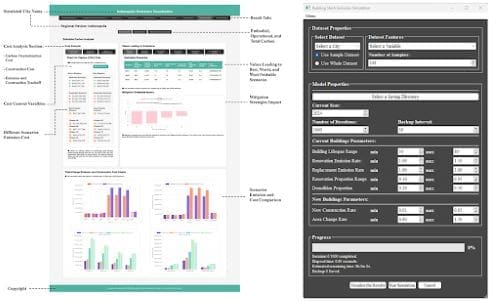
Notre Dame researchers Matthew Sisk, codirector of the Civic-Geospatial Analysis and Learning Lab and associate professor of the practice in the Lucy Family Institute for Data & Society, Chaoli Wang, professor of computer science and engineering and Siyuan Yao, postdoctoral candidate in computer science and engineering, teamed up with Hu and Ghorbany to transform the scenario-based simulations into an AI-powered platform called EcoSphere, with results to be published2 in the August 2025 edition of Automation in Construction.
EcoSphere integrates national building datasets with embodied carbon data, Google Street View, satellite imagery and advanced machine learning techniques to generate graphics that can help city planners and non-experts visualize emissions data.
EcoSphere integrates national building datasets with embodied carbon data, Google Street View, satellite imagery and advanced machine learning techniques to generate readily available graphics that can help city planners and non-experts visualize emissions data. The EcoSphere interface provides information in a visualization dashboard, with the ability to dive deeper into simulation outcomes to understand potential cost implications, variables that drive simulation scenarios, the impact of mitigation strategies and cost and emission comparisons.
To evaluate the tool’s effectiveness, case studies were carried out in Chicago and Indianapolis. In both cities, EcoSphere demonstrated how varying construction methods and policy decisions can significantly impact a city’s carbon footprint and economic costs.
“EcoSphere uses machine learning not just to process these large datasets and imagery – but to understand it,” Sisk said. “By combining computer vision, geospatial analysis and large language models, we can generate detailed carbon profiles in real-time for entire cities, making sustainable urban planning faster, smarter and more accessible.”
Beyond city planning, EcoSphere has wider applications for use in school systems as a teaching tool for students to explore how carbon impacts the environment. Additionally, it can be integrated with smart city and digital twin platforms for real-time decision-making and monitoring. Governments can use it to forecast the long-term effects of policy choices and to craft more effective carbon reduction regulations.
Hu is hopeful that the tools will provide a positive impact for cities in the US, where robust, data-driven strategies can work toward neutralizing carbon emissions.
“Together, these studies show how detailed data and smart software can help empower city planners to make informed decisions for a greener future,” Hu said.
Journal Reference:
1. Ghorbany, S., Hu, M., ‘A systematic framework to reduce urban embodied carbon emissions using urban scale simulation’, npj Urban Sustainability 5, 7 (2025). DOI: 10.1038/s42949-025-00196-x
2. Siavash Ghorbany, Ming Hu, Siyuan Yao, Matthew Sisk, Chaoli Wang, ‘Automating embodied and operational carbon assessment in urban sustainable development’, Automation in Construction 176, 106245 (2025). DOI: 10.1016/j.autcon.2025.106245
Article Source:
Press Release/Material by Christine Grashorn | University of Notre Dame
Forest trees and microbes choreograph their hunt for a ‘balanced diet’ under elevated CO₂
Oak trees change their fine roots and ‘energise’ soil microbes by supplying them with a cocktail of small organic compounds, all to supplement the trees’ supply of essential nutrients when exposed to higher levels of carbon dioxide. This according to a study conducted at the unique University of Birmingham Institute of Forest Research’s Free Air CO2 Enrichment (BIFoR-FACE): a very large outdoor forest research facility.
In a study published in the Proceeding of the National Academy of Sciences (PNAS), researchers at BIFoR-FACE facility discovered that trees growing in a CO2-rich atmosphere tactically choreograph in-soil trading of carbon for nutrients through “do it yourself” and “outsourcing” strategies.
Perspex-sided root boxes, buried in the forest, allowed scientists at BIFoR-FACE access to the soil and roots below giant ~180 years old English oak trees growing in what is expected to be a mid-21st-century atmosphere; that is, an atmosphere containing over a third more CO2. The trees demonstrated their ability to respond to the change of atmosphere by adjusting multiple carbon investment strategies for sourcing soil nutrients.
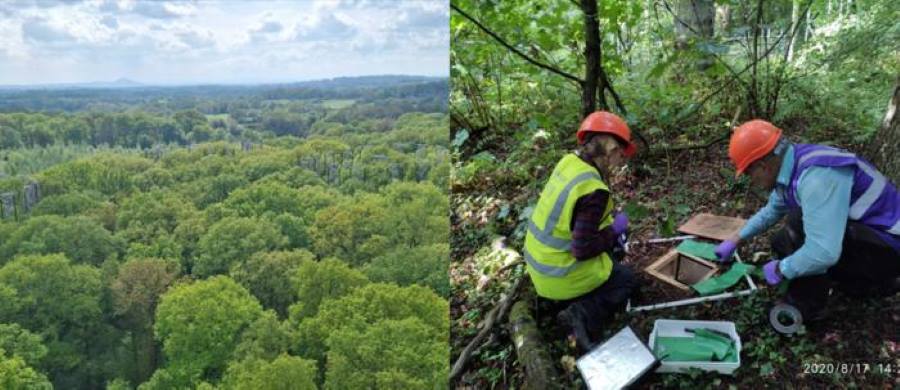
The measurements, made after elevating CO2 in the forest for five years, showed that the oak trees increased their fine root branching systems by 73%, helping the trees explore more of the soil at all times of the year in a “do it yourself strategy” for finding and taking up nutrients. “Outsourcing” strategies, which involve trade partnerships with the soil microbial community, showed distinct seasonal patterns.
Elevated CO₂ sees trees investing more carbon-trading
There was a 63% increase in the release (‘exudation’) of a cocktail of small organic molecules early in spring and autumn, which ‘prime’ soil microbes to release nutrients locked up in soils, so meeting tree nutrient demands. There was also a 17% increase in the amount of symbiotic root-associated fungi in autumn. More remarkable still, under elevated CO2, trees not only invested more carbon in their in-soil trading, they also altered the cocktail of chemicals released as root exudate, providing yet one more ‘outsourcing’ strategy to gain nutrients and sustain growth.
Dr Michaela Reay, the lead author from the University of Bristol, who carried out the research for this study while at the University of Birmingham, said: “Roots do not simply take up nutrients and water from soils but rather exhibit smart and dynamic choreography, which involves highly specialized tradeoffs with soil microbes via varied nutrient exploration strategies throughout the year. These findings indicate that trees are more agile in optimizing growth than previously thought and will continue to be agile under higher CO2 atmospheres as long as soil nutrient supplies are sustained.”
Senior author Professor Sami Ullah from the University of Birmingham said: “These mechanistic insights into how trees growing in future atmospheres acquire soil nutrients will have significant policy implications with direct relevance for climate mitigation initiatives such as the Paris Climate Agreement, the EU Green Deal, and the UK and EU net zero ambitions by 2050. There is growing importance of forests to act as carbon sinks to contribute to offset essential CO2 emissions. Forest growth not only relies on CO2, but also requires an ample supply of soil nutrients to keep capturing and sequestering atmospheric CO2.”
Professor Iain Hartley from Exeter University said: “Trees in this forest increasing their growth under elevated CO2 was slightly unexpected, and suggests mature temperate forests could play a key role in the fight against climate change. It remains important to investigate whether the strategies the oak trees are using will continue to allow for greater access to soil nutrients.”
Since the nutrients available in soil are not unlimited, the question now remains whether the extra carbon investment of trees in nutrient acquisition may eventually exhaust soil nutrient stocks. Forest responses to enforced changes, such as higher atmospheric CO2, can take many years to reach a new balance point; the ongoing research at BIFoR-FACE will assess whether nutrient supplies can continue to meet tree nutrient demands.
Journal Reference:
Michaela K Reay, Emma J. Sayer, Andy Smith, Victoria Pastor, Angeliki Kourmouli, Miles Marshall, Robert T. Grzesik, Iwan Evans, Manon Rumeau, Kris M. Hart, Jiaojiao Ma, R.J. Norby, A. Robert MacKenzie, R. Liz Hamilton, Iain Hartley, Sami Ullah, ‘Elevated CO2 alters relative belowground carbon investment for nutrient acquisition in a mature temperate forest’, Proceedings of the National Academy of Sciences of the USA (2025). DOI: 10.1073/pnas.2503595122 | Access to Document (Bangor University Research)
Article Source:
Press Release/Material by University of Birmingham
Featured image credit: Gerd Altmann | Pixabay




